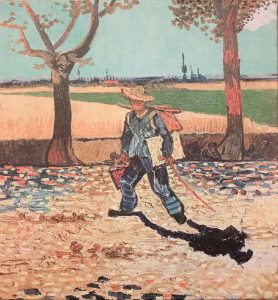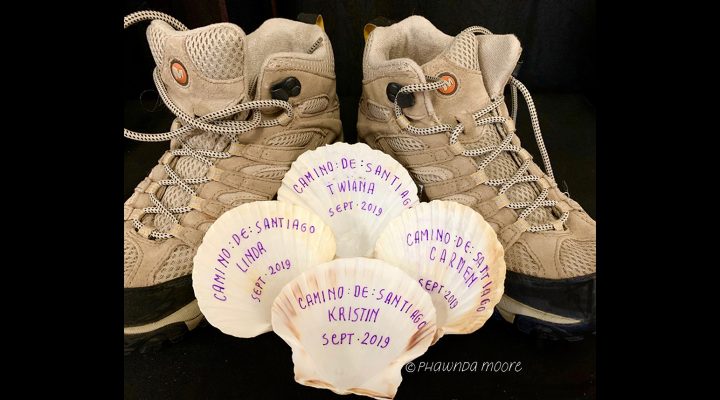Being a pilgrim increasingly seems to fit many life chapters. I’m not speaking of “the” Pilgrims of Plymouth Rock, but as anyone who makes a journey, often to a foreign land, on a quest for spiritual renewal. Many who have walked the Camino de Santiago in Spain are seekers in this way.
The theme of pilgrimage is woven into Christianity and many other religions. In the Bible, Scripture provides individual accounts of devotion to God to explain the meaning of life, sin, suffering, judgment and death.
Throughout the ages, various cultures illustrate that living as pilgrims brings us closer to God and to what’s eternal.

Phawnda Moore
“In Christianity, there are few acts of devotion as rich in history, traditions or spirituality. This is true to such a degree that the image of the pilgrimage has become a metaphorical image of life itself. We are all on a journey heavenward,” writes Deborah Castellano Lubov.
Father Dave Pivonka, who leads pilgrimages around the world, says, “Our very life is a pilgrimage. … At times our lives are too chaotic for us to hear God’s invitation, but if you are able to get away from the madness and be still, you can hear it; you can sense it. It is in the quiet that we understand why we are walking. It is in the stillness that we more fully understand what or whom we are walking toward.”
When a local pilgrim who had walked the Camino de Santiago asked me to personalize shells for her colleagues, I was intrigued with the idea and thought I’d like to make the trek myself. Luckily, others have and they’ve communicated so eloquently that now I’m happy to be an armchair traveler. You can travel along, too, in whatever way works for you.
I’ve followed some of these hikers on Facebook as they document their journey from beginning to end. First, there’s the strategic packing (imagine the dilemma of choosing just a few pairs of shoes!) to the logistics of getting there, nightly shelter and food. Then, other items such as first aid, snacks and clothing to go in a backpack. Oh, and by the way, that’s carried on your back for the duration of your journey.
Many walk a dozen or more miles a day, either without a group or in the company of kindred spirits, which speaks of the reality of this commitment.
Often artists and writers journal their experience, photographing the rolling green mountains, cobbled pavements, various cafes, Medieval bridges, vibrant night life, spectacular Gothic cathedrals and wheat fields.
At the end of the journey, a priest welcomes travelers to celebrate their accomplishments with a giant botafumerio (censer) that dispenses incense.
Ultimately, trekkers say the journey changes them. For the better. And best of all, that the journey is ongoing.
A passionate pilgrim in history was artist Vincent Van Gogh. Son of a pastor, the Dutch, Post-Impressionist artist eventually became one of the most influential figures in Western art. Earlier in his career, though, he felt called by God to serve on a different path, that of a pastor.
In a sermon on Oct. 29, 1876, Van Gogh referenced Psalm 119:19: “I am a stranger on the earth, hide not thy commandments from me.” Van Gogh said, “It is an old belief and it is a good belief, that our life is a pilgrim’s progress — that we are strangers on the earth, but that though this be so, yet we are not alone for our Father is with us. We are pilgrims, our life is a long walk or journey from earth to heaven.”
A prolific letter writer, Van Gogh shared his inner creative calling with his brother, Theo: “Sometimes I long so much to do landscape, just as one would go for a long walk to refresh oneself, and in all of nature, in trees for instance, I see expression and a soul.”
Although he experienced much discouragement, he managed to see nature (the heavens) through God’s eyes: “When I have a terrible need of — shall I say the word — religion, I go out and paint the stars.”

“The Painter on His Way to Work,” Vincent Van Gogh, 1888
He humbly identified with the workers of the fields and painted them with kindness and respect: “I feel that there is nothing more truly artistic than to love people.”
While living and waiting for God’s direction, he tempered his frustrations with patience and purpose. Surely, this pilgrim’s advice is worth considering: “Let us cling to seasons of difficulty and sorrow. … For we are not what we once were, and through these, we shall not remain what we are now.”
Hiking in spirit is how many take this journey. Put on your most comfortable shoes and head out for a personal retreat. In the message of the autumn season, let go of the familiar, become more vulnerable and humbly broaden your horizon.
Walk in a new area to feel grounded and take note of your heightened senses. Stay long enough to experience being there as a pilgrim.
Ask for God’s voice, listen and hold it in your heart. Take the experience and its lessons into each day. It will make a difference in your life. As Van Gogh said, “Our Father is with us.”
Phawnda Moore is a Northern California artist and award-winning author of Lettering from A to Z: 12 Styles & Awesome Projects for a Creative Life. In living a creative life, she shares spiritual insights from traveling, gardening and cooking. Find her on Facebook at Calligraphy & Design by Phawnda and on Instagram at phawnda.moore.


